
Home | Canal System | Historical Documents | 175th Anniversary
Images | Maps | Tour | Traces | Locks | Boats | Books and Videos | Music | Links



On both the old "Clinton's Ditch" and in the early years of the Enlarged Erie Canal, both passenger boats (called "packets" or "packet boats"), usually horse-drawn, and working boats (also called "line boats" or "freighters"), drawn by either horses or mules, were common. Originally intended as a more comfortable alternative to the bone-jarring stagecoach, the packet boat fell out of favor as railroad travel improved, and basically disappeared by the latter half of the 1800s. In addition to the freight carrying working boats, there were also miscellaneous themed boats, including circus boats, boats with animal menageries, museum boats, boats of curiosities, "Gospel" or "mission" boats, temperance boats, and library or book boats. For more information on Book Boats, see Book Boats on the Erie Canal.
On the current Erie (Barge) Canal, there being no towpath, working or line boats were replaced by tugboats ("tugs" or towing boats) with their attached barges, as well as motorized freighters. Today, the most common boats are recreational boats, although commercial traffic still exists, and has actually increased in recent years.

Packet boats came in different sizes, but the most common size was 60-80 feet long by just over 14 feet wide. All featured the same basic accommodations: a multipurpose room which served as lounge, dining room, and sleeping room (with a curtain to separate the ladies and men), and a kitchen. The average charge for traveling on packet boats was 4 cents per mile, and included meals and sleeping accomodations. For those who couldn't afford a packet boat, line boats could take passengers at a charge of 2 cents per mile, and sometimes one cent, but accomodations were proportionally less comfortable and travel somewhat slower.
The first image below features a typical packet boat. Because it was usually hot and stuffy in the cabin in the summer time, passengers commonly sat on deck, what little there was of it, or often on the roof. Because headroom under bridges was usually low, passengers on the roof to had to duck their heads, or occasionally, to flatten themselves to the roof to avoid being swept off the roof into the canal. The second image below illustrates a packet boat passing under a bridge, with passengers heeding the call of "Bridge!" or "Low Bridge!" Because travel on the Erie Canal was a leisurely affair -- the usual speed being four miles per hour -- passengers would sometimes disembark where they could, walk along the canal path for a while and re-board at some other convenient spot, sometimes by jumping onto the roof from a bridge. This method, illustrated in the third image below, also served those adventuresome sorts who wanted to board where there was no docking area.
Travelling on packet boats was a unique experience for many, and more comfortable than stagecoach travel, although sleeping arrangements could be problematic. A number of travellers have written about their experiences, good and bad. Extracts from these accounts can be found on the Packet Boat Stories page.
The packet boat's multipurpose cabin took up nearly all the vessel. It extended the entire width of the boat and stretched from approximately seven feet from the bow, or front of the boat to within six feet of the stern, or rear of the boat. The space forward was known as the bow deck, and had chairs for the women passengers. The six feet of space at the stern was the stern deck, occupied by the tiller and the steersman.
The cabin was long and narrow, well lighted by a series of windows that occupied most of the length of the wall space. Down the center was a narrow table, on which the meals were served. When night came the crew would start to make the beds -- the long benches would fold up to make a lower berth, and two upper berths, which were cot-like affairs, would be made with the inner edge hung from hooks in the ceiling. Each boat was usually equipped with from 60-70 berths in the cabin. Sometimes as many as 100 passengers would be aboard overnight and then the luckless ones would sleep on the floor of the cabin.
Since packet boats were only in use in the first several decades of the nineteenth century, our recollections of them come mainly from prints and paintings:
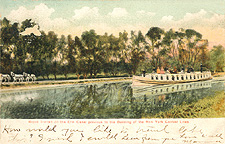 |
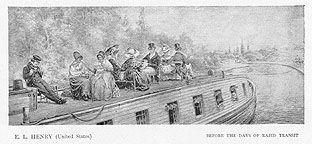 |
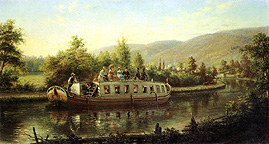 |
| Rapid Transit on the Erie Canal previous to the Building of the New York Central Lines (93432 -- American News Co., New York) -- Postcard ; postmarked July 2, 1907 ; a reproduction of an E. L. Henry painting. | Before the Days of Rapid Transit / Edward Lamson Henry -- from: Official Illustrations From The Art Gallery of The World's Columbian Exposition / edited by Charles M. Kurtz (Philadelphia : George Barrie, 1893) -- p. 301. Another version of this work can be found on the Rochester Images site. | Early Days of Rapid Transit / Edward Lamson Henry -- oil on canvas ; 20 x 36 in. ; Private collection ; available as a reproduction print through: The Athenaeum. |
 |
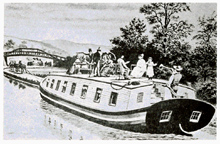 | |
| On the Erie Canal / Frederick Elmiger (no. 2595 -- New York :
Donald Art Co., Inc., c1957) -- print ; 12.5 x 3 in. Two more images of packet boats may be seen on The Erie Canal Home page |
Erie Canal Packet Boat, 1840 era -- from: Fort Hunter - “Canal-Town, U.S.A.” / by David H. Veeder. (Fort Hunter, N.Y. : Fort Hunter Canal Society ; The Noteworthy Co., Amsterdam, N.Y., c1968) -- p. 9. | |
 |
 |
| The "Louise Fisher" (built in Newark), going west from Lyons -- about 1895. |
"Erie Canal Packet Boats" -- Advertisement from: American Traveller, Boston, May 30, 1828. |

| Packet boats like those used in the early 1800s no longer exist. However, cruises on similar replica boats exist at a number of sites, one of which is The Sam Patch, run by Corn Hill Navigation at Schoen Place in Pittsford, N.Y. (see right) |
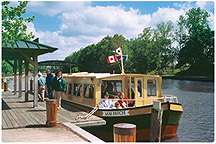 |
For other types of boats, go to the Working Boats page.

http://www.eriecanal.org/boats.html